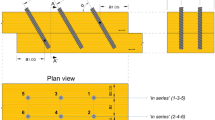Abstract
A mean stress failure criterion is applied to the Volkersen-model used for analysis of lag screws and glued-in rods subjected to withdrawal. Expressions are derived for pull-pull as well as pull-push loading conditions. The solutions for glued-in rods appear as special cases of the theory for lag screws, and the usual solutions for a maximum stress failure criterion appear as special cases of the solutions for a mean stress failure criterion. The theoretical solutions for lag screws are compared with test results, and a suggestion is made for taking into account initial shear stresses caused by the thread of the screw when driving the screw into the wood. The main advantage of considering initial shear stresses is that the number of necessary fitting parameters is limited to one, and that the usual values of shear strength and mode II fracture energy of wood can be applied.
Zusammenfassung
Ein Versagenskriterium auf Basis der mittleren Spannung wird auf das Volkersen-Modell angewandt, um das Ausziehverhalten von Schrauben und eingeklebten Gewindestangen zu untersuchen. Gleichungen wurden sowohl für Zug-Zug-Beanspruchung als auch für Zug-Druck-Beanspruchung hergeleitet. Die Lösungen für eingeklebte Gewindestangen ergeben sich als Sonderfälle der Theorie für Schrauben, und die üblichen Lösungen für ein Versagenskriterium auf Basis der Maximalspannung ergeben sich als Sonderfälle des Versagenskriteriums auf Basis der mittleren Spannung. Die theoretischen Lösungen für Schrauben werden mit den Versuchsergebnissen verglichen und es wird vorgeschlagen, die Schubspannungen, die durch das Schraubengewinde beim Eindrehen der Schraube im Holz entstehen, zu berücksichtigen. Der wesentliche Vorteil bei der Berücksichtung dieser Spannungen liegt darin, dass nur ein Anpassungsparameter benötigt wird und dass die üblichen Werte für die Scherfestigkeit und die Bruchenergie im Modus II angewandt werden können.








Similar content being viewed by others
References
Gustafsson PJ (2002) Mean stress approach and initial crack approach. In: Aicher S, Gustafsson PJ, Haller P, Petersson H (eds) Fracture mechanics models for analysis of timber beams with a hole or a notch—a report of RILEM TC-133. Report TVSM-7134, Lund University, Sweden
Gustafsson PJ, Serrano E (2001) Glued-in rods for timber structures—development of a calculation model. Report TVSM 01/3056, Lund University, Sweden
Japan Standard Association (2005) Japan Industrial Standard (JIS) G4051, Carbon steels for machine structural use. Japan Standard Association, Tokyo
Jensen JL, Koizumi A, Sasaki T, Tamura Y, Iijima Y (2001) Axially loaded glued-in hardwood dowels. Wood Sci Technol 35:73–83
Jensen JL, Quenneville P (2010) Fracture mechanics analysis of row shear failure in dowelled timber connections. Wood Sci Technol. doi:10.1007/s00226-009-0295-9
Johansson C-J, Serrano E, Gustafsson PJ, Enquist B (1995) Axial strength of glued-in bolts. Calculation model based on non-linear fracture mechanics—a preliminary study. CIB W18A, Meeting twenty eight
Ministry of Agriculture, Forestry and Fisheries (2000) Japan Agricultural Standard (JAS) for structural glued laminated timber. Japan Plywood Inspection Corporation, Tokyo
Nakatani M, Komatsu K (2004) Development and verification of theory on pull-out properties of lagscrewbolted timber joints. In: Proceeding of the 8th world conference on timber engineering, Lahti, Finland, pp 95–99
Serrano E, Gustafsson PJ (2006) Fracture mechanics in timber engineering—strength analysis of components and joints. Mat Struct 40:87–96
Sjödin J, Serrano E, Enquist B (2008) An experimental and numerical study of the effect of friction in single dowel joints. Holz Roh-Werkst 66:363–372
Author information
Authors and Affiliations
Corresponding author
Rights and permissions
About this article
Cite this article
Jensen, J.L., Nakatani, M., Quenneville, P. et al. A simple unified model for withdrawal of lag screws and glued-in rods. Eur. J. Wood Prod. 69, 537–544 (2011). https://doi.org/10.1007/s00107-010-0478-y
Received:
Published:
Issue Date:
DOI: https://doi.org/10.1007/s00107-010-0478-y




